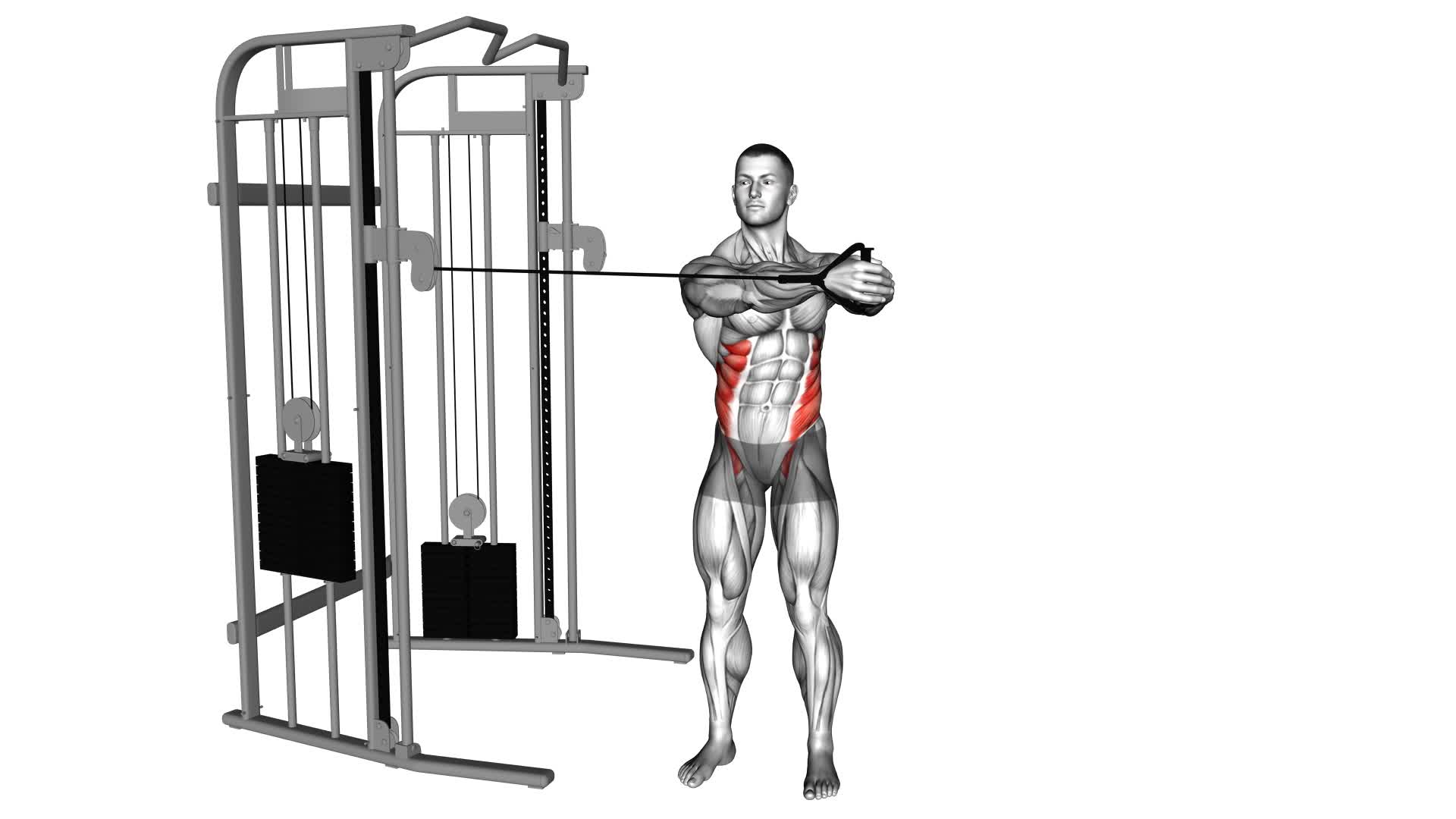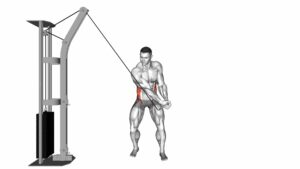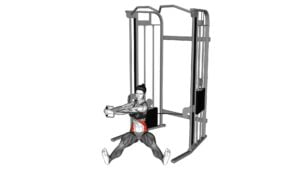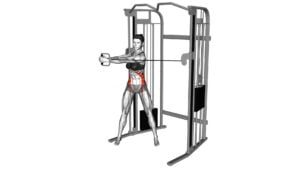Cable Twist – Video Exercise Guide & Tips

Looking to add a new exercise to your workout routine?
Watch This Exercise Video
The Cable Twist is a great option for targeting your core and obliques.
In this video exercise guide, we'll show you the proper form and technique to get the most out of this exercise.
Plus, we'll share variations to challenge yourself even more.
Maximize your cable twist workout and avoid common mistakes with our helpful tips.
Get ready to strengthen and tone with the Cable Twist!
Key Takeaways
- Cable twist and rotational stability training target the core and obliques, improving core strength and rotational stability.
- These exercises add diversity to a workout routine and target different muscle groups.
- Proper form, technique, and body alignment are crucial for maximizing effectiveness and preventing injury.
- Breathing techniques for stability, such as deep inhales and controlled exhales, can enhance stability and maximize workout effectiveness.
Benefits of Cable Twist
Improve your core strength and rotational stability with the Cable Twist exercise. Cable twist variations can add diversity to your workout routine and target different muscle groups.
One variation is the standing cable twist, where you stand perpendicular to the cable machine with your feet shoulder-width apart and hold the cable handle with both hands. Engage your core and rotate your torso away from the machine, keeping your hips and lower body stable.
Another variation is the kneeling cable twist, where you kneel down facing the cable machine and hold the handle with both hands. Keep your back straight and rotate your torso to one side, then return to the starting position and repeat on the other side.
To have an effective cable twist workout, keep these tips in mind. First, maintain proper form by keeping your core engaged and your movements controlled. Avoid jerking or using momentum to twist the cable.
Second, start with lighter weights and gradually increase the resistance as you become more comfortable with the exercise. This will help prevent injury and ensure proper muscle engagement.
Finally, mix up your cable twist routine by incorporating different variations and angles. This will challenge your muscles in new ways and prevent plateauing.
Proper Form and Technique
To ensure you get the most out of your cable twist exercise, it's important to focus on proper form and technique. By avoiding common mistakes such as using momentum or twisting too quickly, you can effectively target your core muscles.
Additionally, maintaining proper body alignment throughout the movement will help prevent strain and injury. Remember to engage your core, exhale during the twist, and inhale as you return to the starting position to maintain stability and maximize the benefits of this exercise.
Avoiding Common Mistakes
Maintain proper form and technique while performing the cable twist exercise to maximize its effectiveness and prevent injury.
To avoid common mistakes, start by ensuring that you have the right resistance level on the cable machine. Using too much weight can compromise your form and increase the risk of injury.
Next, focus on proper execution. Keep your core engaged throughout the exercise to stabilize your spine and maintain balance. Avoid using momentum or jerking movements, as this can strain your muscles and lead to incorrect form.
Additionally, be mindful of your posture and avoid rounding your back or hunching your shoulders.
Importance of Body Alignment
Are you wondering how to achieve proper body alignment and technique while performing the cable twist exercise?
Body alignment is of utmost importance to ensure that you maximize the effectiveness of the exercise and minimize the risk of injury. Proper form and technique not only allow you to engage the targeted muscles more efficiently but also help maintain stability throughout the movement.
When performing the cable twist, make sure to stand tall with your feet shoulder-width apart and your knees slightly bent. Keep your core engaged and your back straight throughout the exercise.
As you rotate your torso, focus on using your obliques and abdominal muscles to generate the movement. Remember to maintain control and avoid any jerking or twisting motions.
Breathing Techniques for Stability
When performing the cable twist exercise, it's important to focus on your breathing techniques for stability. Proper breathing helps to engage your core muscles, maintain balance, and improve overall performance. Here are some diaphragmatic breathing and breath control techniques to enhance your stability during the cable twist:
- Deep inhale: Take a deep breath in through your nose, filling your lungs and expanding your diaphragm.
- Controlled exhale: Slowly exhale through your mouth, engaging your core muscles and maintaining control throughout the movement.
- Timing with the twist: Coordinate your breath with the twisting motion, inhaling as you prepare and exhaling as you rotate.
- Consistent rhythm: Maintain a steady breathing rhythm throughout the exercise, focusing on smooth, controlled breaths.
By incorporating these breathing techniques, you'll enhance your stability and get the most out of your cable twist workout.
Now, let's explore some cable twist variations for added challenge.
Cable Twist Variations for Added Challenge
To increase the difficulty of cable twists, incorporate various challenging variations into your workout routine.
Cable twist modifications and advanced cable twist exercises can take your core workout to the next level. One modification you can try is the single-arm cable twist. Instead of using both arms to twist, use only one arm at a time while keeping your core engaged. This variation increases the instability and forces your core muscles to work harder to maintain balance.
Another challenging variation is the kneeling cable twist. Instead of standing, kneel down while holding the cable handle at chest level. This variation adds an element of instability and requires more core strength to stabilize your body.
Lastly, you can try the standing cable twist with a resistance band. Attach a resistance band to the cable machine and hold both ends of the band with your hands. As you twist, the resistance from the band adds an extra challenge to your core muscles.
Incorporating these cable twist variations into your routine will help you develop a stronger and more stable core.
Targeted Muscles During Cable Twist
When performing cable twists, you engage your core muscles to maintain stability and control throughout the movement.
This exercise is particularly effective for rotational stability training, as it targets the muscles responsible for twisting and rotating the torso.
Engaging Core Muscles
Engage your core muscles during the cable twist exercise for maximum effectiveness. By doing so, you won't only strengthen your obliques but also improve your overall stability and balance. Here's how to engage your core muscles during the cable twist:
- Start by standing with your feet shoulder-width apart and your knees slightly bent.
- Keep your spine straight and your shoulders relaxed.
- As you twist, focus on contracting your abdominal muscles and obliques.
- Exhale as you twist and inhale as you return to the starting position.
Engaging your core muscles during the cable twist will help you get the most out of this exercise and achieve better results. So remember to activate those muscles and feel the burn!
Rotational Stability Training
By engaging your core muscles during the cable twist, you can target and train your rotational stability. Rotational stability training, also known as rotational training, is beneficial for athletes and individuals looking to improve their overall performance and functional movement.
It helps to enhance core strength, improve balance, and increase flexibility. Rotational stability exercises involve twisting motions that activate the muscles in your core, including the obliques, transverse abdominis, and erector spinae.
Effective exercises for rotational stability include cable twists, Russian twists, medicine ball throws, and woodchops. These exercises require controlled and coordinated movements, engaging multiple muscle groups to stabilize and rotate the spine.
Incorporating rotational stability training into your fitness routine can help improve your athletic performance and reduce the risk of injuries related to rotational movements.
Tips for Maximizing Your Cable Twist Workout
Maximize your cable twist workout by incorporating these key tips:
- Focus on form: Proper form is essential for maximizing results and avoiding injury during cable twist exercises. Keep your core engaged, maintain a neutral spine, and use controlled movements to ensure you're targeting the right muscles.
- Increase resistance gradually: As you become more comfortable with cable twist exercises, gradually increase the resistance to challenge your muscles and continue making progress. This will help to maximize the effectiveness of the workout and prevent plateauing.
- Vary your exercises: Don't limit yourself to just one cable twist exercise. Incorporate different variations, such as standing cable twists, kneeling cable twists, or woodchopper cable twists, to target different muscle groups and keep your workouts interesting.
- Add intensity with tempo: To further maximize your cable twist workout, try incorporating tempo variations. Slow down the movement on the way back to increase time under tension and really engage your core muscles. This will help to make your workouts more challenging and effective.
By following these tips, you can ensure that you're getting the most out of your cable twist workout.
Now, let's discuss the common mistakes to avoid during cable twist exercises.
Common Mistakes to Avoid During Cable Twist
To avoid common mistakes during cable twist exercises, focus on maintaining proper form and using controlled movements. This will help you prevent injury and improve your balance. One common mistake to avoid is using too much weight. It's important to start with a weight that you can handle comfortably and gradually increase as you build strength. Using too much weight can lead to improper form and put unnecessary strain on your muscles and joints.
Another mistake to avoid is twisting your body too forcefully. While it may be tempting to generate momentum and twist quickly, it can compromise the effectiveness of the exercise and increase the risk of injury. Instead, focus on slow and controlled movements, engaging your core muscles throughout the exercise.
Additionally, ensure that you're using the proper equipment and attachments for cable twist exercises. Using the wrong attachments can limit your range of motion and affect your form. Make sure the cable is at the appropriate height and that you're using a handle or rope that allows for a comfortable grip.
Frequently Asked Questions
How Many Calories Can Be Burned During a Cable Twist Workout?
During a cable twist workout, you can burn a significant number of calories while also improving your posture. The exact number of calories burned will depend on factors such as your weight, intensity of the workout, and duration.
Cable twists engage multiple muscle groups, including your core, obliques, and shoulders, making it an effective exercise for calorie burning.
Additionally, the twisting motion can help improve spinal mobility and strengthen your abdominal muscles.
Can Cable Twists Help Improve Posture?
Cable twists are a great exercise to improve your posture. By engaging your core and back muscles, cable twists help strengthen the muscles that support your spine, leading to better posture.
The rotational movement of cable twists also helps to increase flexibility and mobility in your upper body.
Additionally, cable twists can be modified with different variations to target different muscle groups and add variety to your workout routine.
Is It Necessary to Warm up Before Performing Cable Twists?
Before performing cable twists, it's necessary to warm up. Warming up helps prepare your muscles for the exercise by increasing blood flow and flexibility. This reduces the risk of injury and allows for better performance.
Benefits of cable twists include strengthening your core, obliques, and improving rotational power. There are also variations of cable twists that can target different muscle groups or add challenge.
Can Cable Twists Be Modified for Individuals With Back Pain?
Having back pain? Don't worry, cable twists can be modified for you.
There are alternative exercises that can provide similar benefits without putting strain on your back.
By incorporating modifications like using lighter weights or performing the exercise seated, you can still engage your core and obliques without exacerbating your pain.
Are There Any Specific Breathing Techniques to Follow During Cable Twists?
During cable twists, it's important to follow specific breathing techniques to maximize the benefits. By focusing on your breathing patterns, you can enhance your core stability and overall control.
Controlled breathing helps engage your deep abdominal muscles and improves your body's ability to stabilize during the exercise. This not only strengthens your core but also reduces the risk of injury.
Conclusion
Incorporating cable twists into your workout routine can provide numerous benefits, including improved core strength and stability. By maintaining proper form and technique, you can effectively target your oblique muscles while also engaging your shoulders, back, and hips.
To add more challenge to your cable twist workout, you can try variations such as standing on one leg or increasing the resistance. Remember to avoid common mistakes and follow these tips to maximize the effectiveness of your cable twist exercise.

Author
Years ago, the spark of my life’s passion ignited in my mind the moment I stepped into the local gym for the first time. The inaugural bead of perspiration, the initial endeavor, the very first surge of endorphins, and a sense of pride that washed over me post-workout marked the beginning of my deep-seated interest in strength sports, fitness, and sports nutrition. This very curiosity blossomed rapidly into a profound fascination, propelling me to earn a Master’s degree in Physical Education from the Academy of Physical Education in Krakow, followed by a Sports Manager diploma from the Jagiellonian University. My journey of growth led me to gain more specialized qualifications, such as being a certified personal trainer with a focus on sports dietetics, a lifeguard, and an instructor for wellness and corrective gymnastics. Theoretical knowledge paired seamlessly with practical experience, reinforcing my belief that the transformation of individuals under my guidance was also a reflection of my personal growth. This belief holds true even today. Each day, I strive to push the boundaries and explore new realms. These realms gently elevate me to greater heights. The unique combination of passion for my field and the continuous quest for growth fuels my drive to break new ground.







